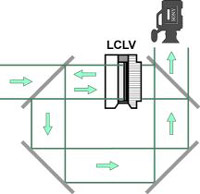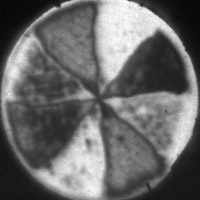| |
|
|
Optical Pattern Formation
Supervisor:
Dr. Nikolaev I.P.
|
|
|
|

Fig.
1

Fig.
2
|
The investigation of
nonlinear optical
systems with distributed feedback
is one of the main directions of scientific research carried out
in our laboratory. Such a system can be conveniently built on
the basis of a
Liquid-Crystal Light Valve
(LCLV). This device transforms intensity modulation of the write
beam into phase modulation of the readout beam. In turn, the
feedback loop provides a phase-to-intensity transformation based
on one of the following physical effects:
interference,
diffraction,
spatial filtering,
or combinations. As a result, the LCLV-based optical feedback
system becomes a generator of
optical patterns,
either static or dynamic. The type of the pattern excited
depends on the chosen type of the
phase-to-intensity
transformation, as
well as on possible geometrical transformations of the feedback
beam (such as linear translation, rotation, scaling, etc.).
We have succeeded in
experimentally observing and studying the following types of
optical patterns:
excitation fronts,
leading centers
generating circular waves converging to the center or diverging
from it, optical
reverberators,
spiral waves,
rolls,
hexagons,
spatio-temporal
optical chaos. When
studying the optical patterns, we always compare experimental
data, analytical results, and results of numerical simulations,
trying to better understand the general properties of spatially
distributed nonlinear systems.
Last three years we
started a new direction of optical pattern studies, which
concerns the use of
azo-containing polymers
as nonlinear elements in optical feedback systems. This idea
seems to be promising in the sense of looking for new spatio-temporal
regimes to develop in such systems. The expectation is based on
the fact that the optical nonlinearity of the considered
polymers is more complex than the
Kerr-type nonlinearity
of an LCLV: laser radiation
locally changes not only the refractive index of the irradiated
polymer but its absorption coefficient as well. We are now
interested both in studying the effect of laser radiation on the
optical properties of an azo-containing polymer and in realizing
some configurations of optical feedback systems based on films
of such polymers.
Studying the optical
pattern formation, we are involved in international
collaboration with a number of researches: Prof. Vladimir
Wataghin (Universita di Torino, Italy), Dr. Stefania Residori (Institut
Nonlineare de Nice, France), and many others.
|
|
|
|
PUBLICATIONS:
Larichev A.V., Nikolaev
I.P., and Chulichkov A.L., Spatiotemporal period doubling in a
nonlinear interferometer with distributed optical feedback, Opt.
Lett. 21 (1996) 1180.
Ramazza P., Residori S.,
Pampaloni E., and Larichev A.V., Transition to space-time chaos
in a nonlinear optical system with two-dimensional feedback,
Phys. Rev. A 53 (1996) 400.
Nikolaev I.P., Larichev
A.V., Degtiarev E.V., and Wataghin V., An optical feedback
nonlinear system with a Takens-Bogdanov point: experimental
investigation, Physica D 144 (2000) 221.
Wataghin V., Nikolaev
I.P., Degtiarev E.V., Larichev A.V., and Nesterouk M.Yu,
Nonlinear optical systems with multiparameter bifurcations,
Laser Physics 11 (2001) 555.
Nikolaev I.P., Nesterouk
K.S., Larichev A.V., and Wataghin V., Analytical description of
the effect of laser radiation on optical properties of amorphous
azo-containing polymers, Laser Physics 12 (2002) 978.
 |
|